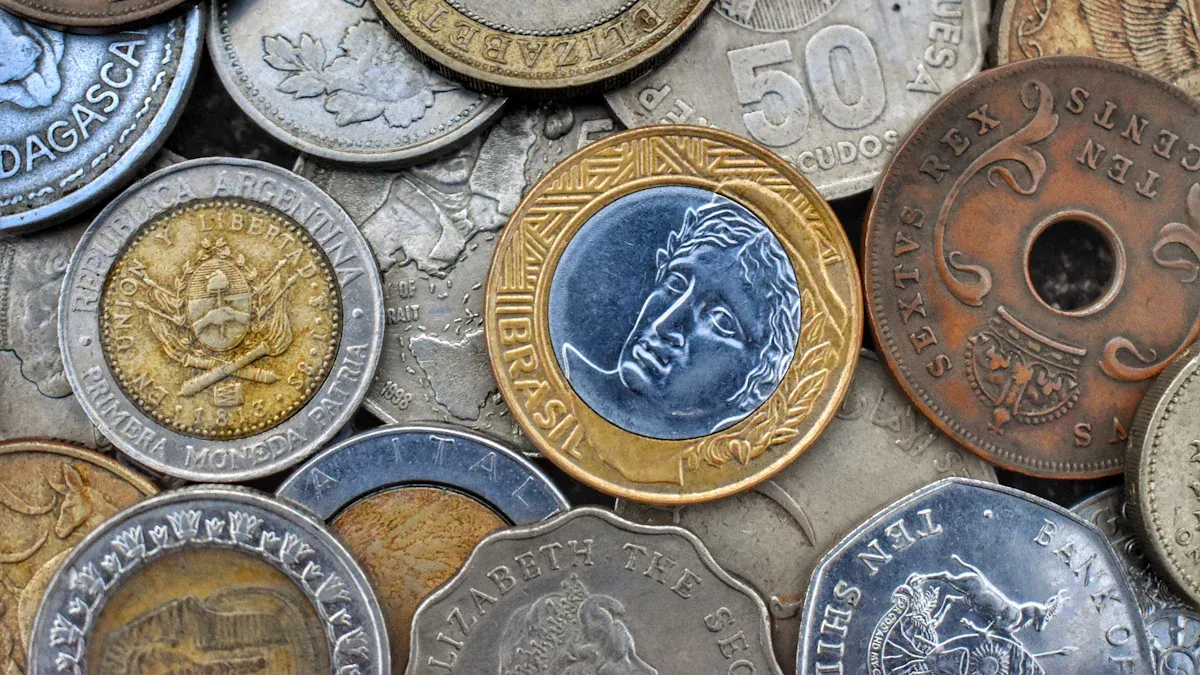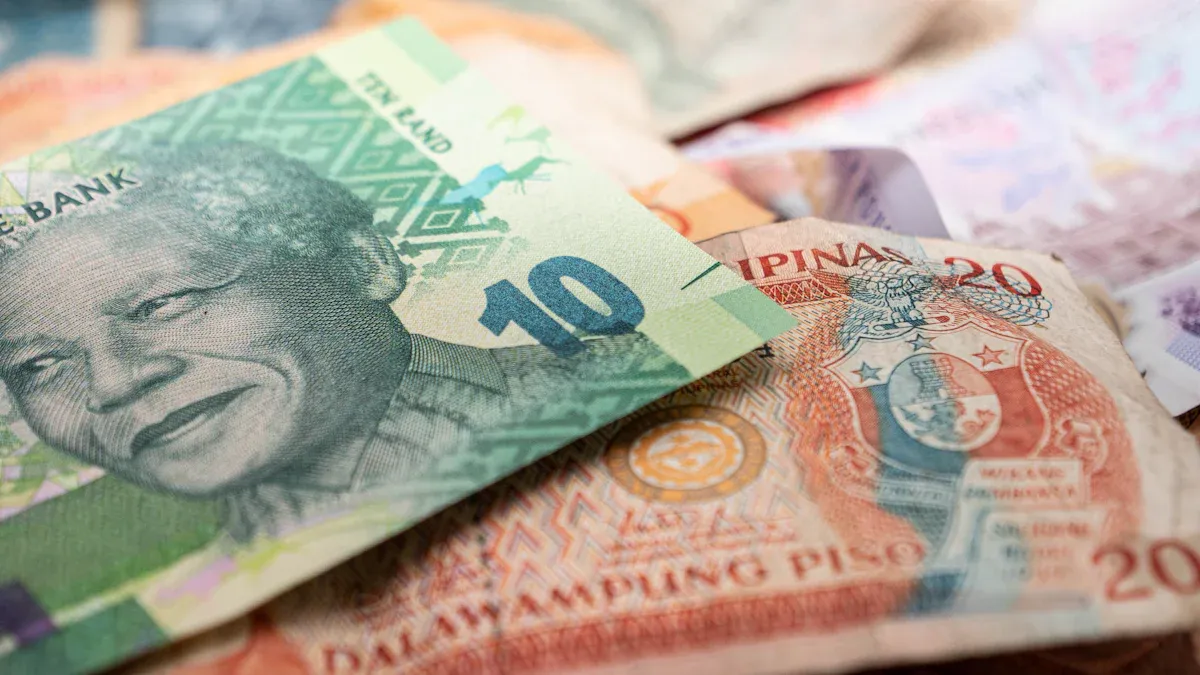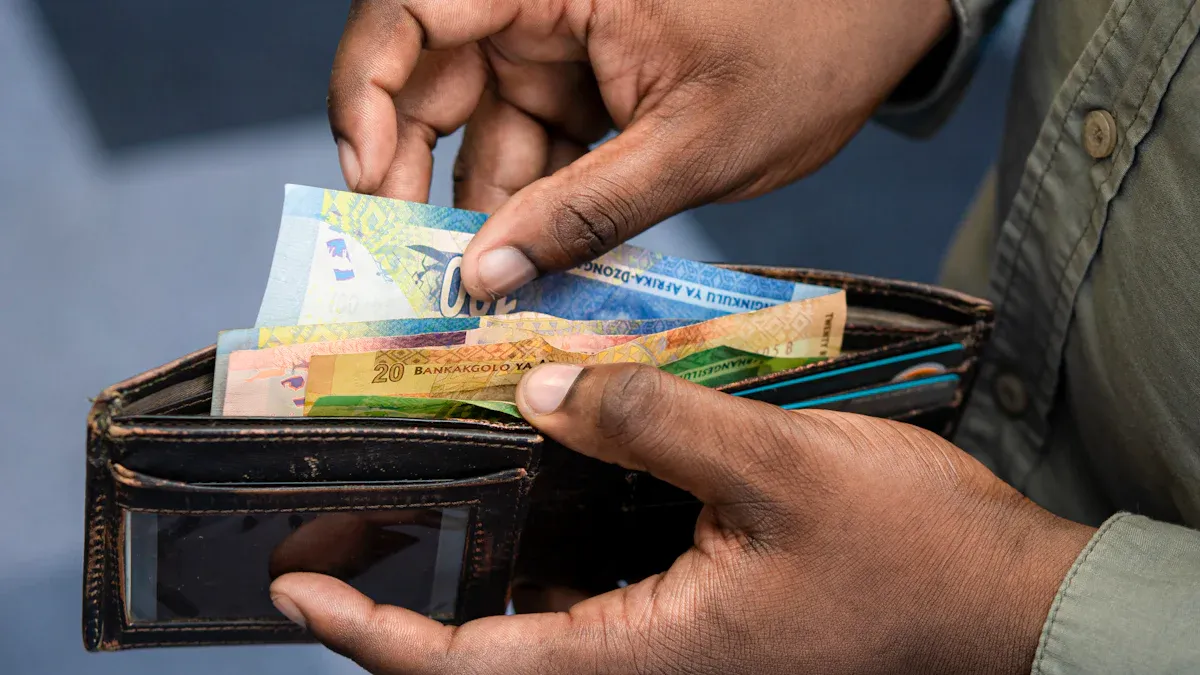- EasyCard
- Trade
- Help
- Announcement
- Academy
- SWIFT Code
- Iban Number
- Referral
- Customer Service
- Blog
- Creator
The South African Currency: The History and Exchange Methods of the Rand

Image Source: pexels
The official currency of South Africa is the Rand, with the international standard code ZAR and the common symbol “R”. Understanding the basic information about the South African currency Rand is crucial for travelers or business people planning to visit South Africa. Currency values change dynamically, so having access to real-time exchange rate information is very helpful.
Current exchange rate reference:
- The mid-market exchange rate of South African Rand (ZAR) to Chinese Yuan (CNY) is approximately 1 ZAR = 0.4114 CNY.
- The exchange rate of US Dollar (USD) to Rand varies due to multiple factors, and the specific value needs to be checked and confirmed at the time of use.
Key Takeaways
- The South African currency is the Rand, which was introduced in 1961, replacing the South African pound.
- Rand banknotes feature Nelson Mandela’s portrait and the “Big Five” animals, while coins showcase South African flora and fauna.
- In South Africa, you can exchange Rand at banks or authorized exchange providers; airport exchange rates are usually poor.
- When paying with a credit card, choosing to pay in the local currency (Rand) can save on fees.
- When withdrawing cash from ATMs, be cautious of scams and protect your personal information.
South African Currency Rand: History and Features

Image Source: pexels
Understanding the story behind the South African currency Rand can help travelers better appreciate the country’s culture and economy. The history of the Rand is closely tied to modern South African history, and its design fully showcases the nation’s natural and cultural heritage.
The Birth and Evolution of the Rand
The Rand was officially introduced in 1961 to replace the South African pound. That same year, South Africa declared itself a republic. The name Rand comes from the Witwatersrand, a gold-rich ridge near Johannesburg, symbolizing South Africa’s abundant mineral resources.
Since its introduction, the Rand’s value has experienced multiple fluctuations, often linked to major political and economic events.
- 1971: The Rand decoupled from the British pound and pegged to the US dollar, a key step toward an independent exchange rate system.
- 1980s: Due to high inflation and international sanctions against apartheid, the Rand’s value began to erode. In 1982, its exchange rate against the USD fell below parity for the first time.
- 1994: After South Africa’s first democratic elections, the Rand depreciated further.
- 2001: Influenced by global events like “9/11,” the Rand against the USD exchange rate hit a historic low of 13.84 in December of that year.
These historical milestones have collectively shaped the Rand’s value today.
Currency Symbol and Denomination Identification
The currently circulating South African banknotes and coins are beautifully designed and easy to identify.
Banknotes The circulating banknote denominations are mainly five: 10, 20, 50, 100, and 200 Rand. All banknotes feature the portrait of South Africa’s founding father, Nelson Mandela, on the front. The backs showcase Africa’s famous “Big Five” animals, and the new designs also include their cubs, symbolizing family and heritage.
| Animal | Banknote Denomination | Symbolic Meaning |
|---|---|---|
| Rhino | R10 | Strength, family bonds, resilience |
| Elephant | R20 | Wisdom, strength, complex social emotions |
| Lion | R50 | Courage, strength, leadership |
| Buffalo | R100 | Resilience, endurance, role in the ecosystem |
| Leopard | R200 | Elegance, agility, revered status in traditional culture |
Security Tip: New Rand banknotes have advanced anti-counterfeiting features. For example, when tilting the banknote, the security thread and SPARK® Live animal-shaped elements display dynamic color changes.
Coins Circulating coin denominations include 10 cents, 20 cents, 50 cents, and 1, 2, 5 Rand. The new series issued in 2023 showcases unique South African flora and fauna, such as the 1 Rand coin depicting the national flower, the King Protea, and the 5 Rand coin featuring the Southern Right Whale.
Rand Exchange Guide

Image Source: pexels
Successfully exchanging currency is key to a successful trip to South Africa. Understanding different exchange channels, how to check exchange rates, and regulations for departing the country can help travelers save money and avoid unnecessary trouble.
Comparison of Main Exchange Channels
In South Africa, travelers can exchange currency through various channels. Each channel has its unique advantages and disadvantages; choosing the one that best fits your itinerary is important.
| Exchange Channel | Advantages | Disadvantages |
|---|---|---|
| Airport Exchange Counters | Available immediately upon arrival, very convenient, suitable for emergencies. | Usually the worst exchange rates, possibly higher fees. |
| Local Banks | Relatively fair rates, branches throughout cities, safe and reliable. | Limited operating hours, may require queuing, slower process. |
| Authorized Currency Exchangers | Rates usually more competitive than banks, lower fees. | Fewer locations than banks, need to identify legitimate merchants. |
| Online Exchange Platforms | Rates close to mid-market, high transparency, convenient operation. | Requires pre-registration, not suitable for no-internet or urgent cash needs. |
- Bank Options: Major South African banks like Standard Bank and First National Bank (FNB) offer foreign exchange services. They are reliable choices, especially for larger amounts.
- Authorized Exchangers: In major cities like Johannesburg and Cape Town, you can find numerous authorized exchangers such as Travelex, Bidvest Bank/Rennies Foreign Exchange, Master Currency. These institutions usually offer better rates than traditional banks.
- Online Platforms: Some emerging online services (like Grey) provide multi-currency accounts and exchanges close to real-time market rates with almost no hidden fees, preserving more value for users.
Practical Advice 💡 It is recommended to exchange a small amount of Rand cash before departure for emergencies, or exchange a small amount for immediate needs upon airport arrival. For large South African currency exchanges, it is advised to go to downtown banks or reputable authorized exchangers for better rates.
Exchange Rate Checking and Fees
Exchange rates change dynamically, influenced by global economic and political factors. Therefore, checking real-time rates before exchanging is crucial.
1. Checking Real-Time Rates Travelers can use professional online currency converters to check the “mid-market rate” (Mid-market Rate). This is the wholesale rate used in transactions between banks and large institutions and the best benchmark for evaluating if a deal is worthwhile.
- Websites like ValutaFX provide real-time Rand to USD and other major currencies rates, helping users understand the true value of their funds.
- Platforms like XTransfer also offer 24/7 online exchange services with competitive market rates.
2. Beware of Hidden Fees Many exchange services advertise “zero commission” or “zero fees,” but this does not mean the exchange is free. Fees are often hidden in unfavorable rates.
Fee Structure Breakdown The rate offered to customers by exchange institutions is usually the “mid-market rate” plus a hidden markup. This markup is their profit source and can sometimes be higher than explicitly charged service fees.
Common fees include:
- Exchange Rate Markup: The primary hidden cost.
- Fixed Transaction Fee: A fixed fee per transaction regardless of amount.
- Commission: A percentage of the exchange amount.
Therefore, before exchanging, always compare the provider’s rate with the real-time mid-market rate and calculate the final amount received.
Reverse Currency Exchange Upon Departure
At the end of your trip, if you have unused Rand cash left, you can exchange it back to your home currency.
Keep Exchange Receipts When exchanging Rand back to foreign currency in South Africa, some banks or exchangers may require the original exchange receipt. Therefore, it is very important to keep all receipts or vouchers from each currency exchange.
Cash Carry Limits South Africa has clear regulations on the amount of cash carried when departing, which all travelers must comply with.
- Rand Cash: Each foreign tourist can carry up to 25,000 Rand in cash out of the country without declaration.
- Foreign Currency Cash: Carrying foreign currency cash, gold coins, or collectibles equivalent to more than 10,000 USD requires declaration to customs.
If carrying cash exceeding the above limits, be sure to declare it proactively to customs officials upon departure to avoid violating relevant laws.
Electronic Payments and Cash Withdrawal Practices
With technological advancements, electronic payments and ATM withdrawals have become the most convenient ways to manage funds while traveling. Understanding how to use these tools safely and efficiently in South Africa can greatly enhance your travel experience.
Credit and Debit Card Usage
Using international credit and debit cards is very common in South Africa, but acceptance varies by region.
- Widely Accepted Areas: In major cities like Johannesburg and Cape Town, most hotels, chain restaurants, large shopping malls, and tourist attractions widely accept Visa and MasterCard international credit cards.
- Limited Acceptance Areas: In remote rural areas, small family guesthouses, or local markets, merchants may only accept cash. Therefore, carrying some cash as backup when visiting these areas is wise.
Travelers using credit cards need not worry about minimum spend requirements. By regulation, South African merchants generally cannot set minimum spend thresholds for Visa and other credit card transactions.
💡 Practical Tip: Beware of Dynamic Currency Conversion (DCC)
When swiping your card in South Africa, some merchants may offer the “Dynamic Currency Conversion (DCC)” option, asking if you want to pay in your home currency (e.g., USD) or the local currency (Rand, ZAR).
Although paying in your home currency seems convenient because you immediately know how much you spent, it is usually not cost-effective. Merchants or their partners providing DCC set their own exchange rates, which are typically about 4% or more above the market rate.
To save money, the best choice is always: choose to pay in the local currency (Rand).
This way, the transaction will be settled by your card issuer at its rate, which is usually much better than the DCC rate. According to Visa regulations, merchants must clearly display the following and let you choose:
- Transaction amount in both local and your home currency.
- The exchange rate used and any additional fees or markups.
- A clear option to accept or reject DCC.
If you feel pressured or the merchant fails to provide clear information, it is recommended to reject the DCC offer.
ATM Withdrawal Guide
Withdrawing South African currency cash from ATMs in South Africa is a convenient and quick method, with major banks’ ATMs located throughout cities and towns. However, using a foreign bank card for withdrawals involves several potential fees.
- International Withdrawal Fee: Your card issuer may charge a fixed fee for each overseas withdrawal, typically around 5 USD.
- Foreign Transaction Fee: Your card issuer may charge a percentage (usually about 3%) of the withdrawal amount for currency conversion.
- ATM Operator Fee: The local South African bank owning the ATM may also charge an operation fee.
- Credit Card Cash Advance Fee: If using a credit card for withdrawal, you will incur higher cash advance fees and interest.
Additionally, South African ATMs have daily withdrawal limits.
| Country/Region | Daily International ATM Withdrawal Limit |
|---|---|
| South Africa | R 20,000 |
Note: This limit is set by local South African banks and may vary. Your card issuer may also have its own daily limit. It is recommended to follow the lower of the two.
Payment Security Precautions
South Africa’s digital payment environment is quite mature, but it comes with the risk of payment fraud. According to statistics, digital banking fraud cases in South Africa have been rising in recent years.
- In 2022, total losses from digital banking fraud in South Africa reached hundreds of millions of Rand.
- Among them, banking app fraud increased by 36% year-over-year.
- The average loss per online banking fraud incident increased by 9%.
These data remind all travelers to remain vigilant while enjoying payment convenience.
🔒 Security Alert: Prevent Common ATM Scams
1. Card Skimming Criminals install a tiny device on the ATM card slot to copy your card’s magnetic strip information and use a hidden camera to record your PIN.
- Prevention: Before using an ATM, check the card slot, keypad, and surroundings for suspicious attachments. Cover the keypad with your other hand or body when entering your PIN.
2. Shoulder Surfing Scammers stand behind you to peek at your PIN or other information.
- Prevention: Be aware of your surroundings while withdrawing, keep a safe distance from others. If someone is too close, stop and switch to another ATM.
3. “Helpful” Strangers** Scammers may pretend to be “helpful” to offer assistance and steal or swap your card in the process.
- Prevention: Firmly refuse any “help” from strangers. If the ATM malfunctions, retrieve your card and contact the bank.
If your bank card is unfortunately lost or stolen in South Africa, take the following immediate actions:
- Contact Your Card Issuer Immediately: Call your card’s 24-hour overseas customer service hotline (e.g., FNB’s lost card hotline 087 575 9406), report the loss or theft, and request an immediate account freeze.
- Contact the Card Network: You can also contact Visa or MasterCard’s global emergency service centers. They can assist in reporting to your issuer and, with bank authorization, arrange emergency cash support or issue an emergency replacement card within 1-3 business days.
- Secure Your PIN: Never write your PIN on the card or store it with the card. Activate your bank’s transaction notification service to receive immediate alerts for any account activity.
The South African Rand is not only a medium of exchange; its design featuring Nelson Mandela’s portrait and the “Big Five” animals is also a unique cultural calling card. Although South Africa’s digital payment adoption rate has reached 70.5%, cash remains essential in daily spending.
Best Strategy Recommendations 💡
- Large Expenses: Use credit cards for payments whenever possible—safe and convenient.
- Daily Expenses: Based on your travel budget (e.g., mid-range about R3,111 per day), exchange sufficient cash at downtown banks or authorized exchangers.
- Emergency Funds: Exchange a small amount of South African currency at the airport upon arrival as backup.
Planning your currency strategy in advance is key to ensuring a smooth and cost-effective trip to South Africa.
FAQ
How much cash should I bring to South Africa?
Travelers do not need to carry large amounts of cash. It is recommended to exchange a small amount for emergencies at the airport. Use credit cards for large expenses. Obtain cash for daily needs at downtown banks or authorized exchangers for better rates.
Can I use credit cards everywhere in South Africa?
Not entirely. Hotels, malls, and restaurants in major cities like Johannesburg and Cape Town generally accept credit cards. However, in remote areas, small town markets, or some guesthouses, merchants may only accept cash. Therefore, carrying some Rand cash is necessary.
Where is the best place to exchange Rand?
Downtown banks or reputable authorized currency exchangers (such as Bidvest Bank/Rennies Foreign Exchange) are the best choices. They usually offer more competitive rates than airport counters and possibly lower fees.
What should I pay attention to when using ATMs for withdrawals?
- Security: Check the ATM for abnormalities before use; cover the keypad when entering your password.
- Beware of Others: Refuse “help” from strangers; keep a safe distance from people around you.
- Understand Fees: Using a foreign bank card for withdrawals incurs fees, including those from your issuer and the local bank.
*This article is provided for general information purposes and does not constitute legal, tax or other professional advice from BiyaPay or its subsidiaries and its affiliates, and it is not intended as a substitute for obtaining advice from a financial advisor or any other professional.
We make no representations, warranties or warranties, express or implied, as to the accuracy, completeness or timeliness of the contents of this publication.




Contact Us
Company and Team
BiyaPay Products
Customer Services
is a broker-dealer registered with the U.S. Securities and Exchange Commission (SEC) (No.: 802-127417), member of the Financial Industry Regulatory Authority (FINRA) (CRD: 325027), member of the Securities Investor Protection Corporation (SIPC), and regulated by FINRA and SEC.
registered with the US Financial Crimes Enforcement Network (FinCEN), as a Money Services Business (MSB), registration number: 31000218637349, and regulated by FinCEN.
registered as Financial Service Provider (FSP number: FSP1007221) in New Zealand, and is a member of the Financial Dispute Resolution Scheme, a New Zealand independent dispute resolution service provider.




















